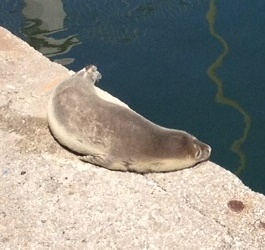Earless seal
Earless seals, also known as true seals or phocids, are a family of marine mammals within the order Carnivora. They are one of the three main groups of seals, alongside the eared seals (otariids) and the walrus (odobenids). Earless seals lack external ear flaps and have a more streamlined body shape compared to eared seals. They are found in coastal waters and icy regions across the globe, from the Arctic and Antarctic to tropical seas.
Characteristics[edit | edit source]
Earless seals are distinguished by their lack of external ears, a feature that sets them apart from the eared seals. They have a sleek, torpedo-shaped body which is well adapted to their aquatic lifestyle. Their limbs are evolved into flippers, with the rear flippers unable to rotate under their bodies, making them less agile on land compared to eared seals. However, this adaptation allows them to be more efficient swimmers, with movements that are more akin to gliding through the water.
Their thick layer of blubber not only serves as insulation in the cold waters but also as an energy reserve. Earless seals have a variety of diets, ranging from fish, squid, and krill, depending on their species and habitat.
Reproduction[edit | edit source]
The reproductive strategies of earless seals vary among species. Generally, they are known for their on-land breeding colonies, where they come ashore in large numbers to give birth and mate. After a gestation period that can last several months, females give birth to a single pup. The mother's milk is extremely rich in fat, allowing the pup to grow rapidly. Shortly after weaning, mating occurs, and the cycle begins anew.
Conservation[edit | edit source]
Many species of earless seals are faced with threats from human activities, including hunting, fishing, and habitat destruction. Climate change and the melting of sea ice also pose significant threats to those species dependent on ice for breeding. Conservation efforts are in place for several species, with some success stories in population recovery.
Species[edit | edit source]
The family Phocidae includes a variety of species, such as the harp seal, grey seal, monk seal, and elephant seal. Each species has adapted to its specific environment, from the ice-covered waters of the Arctic and Antarctic to the warmer waters of the Mediterranean and Caribbean.
In Culture[edit | edit source]
Earless seals have been featured in various cultures throughout history, often symbolizing characteristics such as playfulness and adaptability. They have also been hunted for their fur, meat, and oil, which has led to significant declines in some populations.
See Also[edit | edit source]
Navigation: Wellness - Encyclopedia - Health topics - Disease Index - Drugs - World Directory - Gray's Anatomy - Keto diet - Recipes
Search WikiMD
Ad.Tired of being Overweight? Try W8MD's physician weight loss program.
Semaglutide (Ozempic / Wegovy and Tirzepatide (Mounjaro / Zepbound) available.
Advertise on WikiMD
WikiMD is not a substitute for professional medical advice. See full disclaimer.
Credits:Most images are courtesy of Wikimedia commons, and templates Wikipedia, licensed under CC BY SA or similar.Contributors: Prab R. Tumpati, MD





